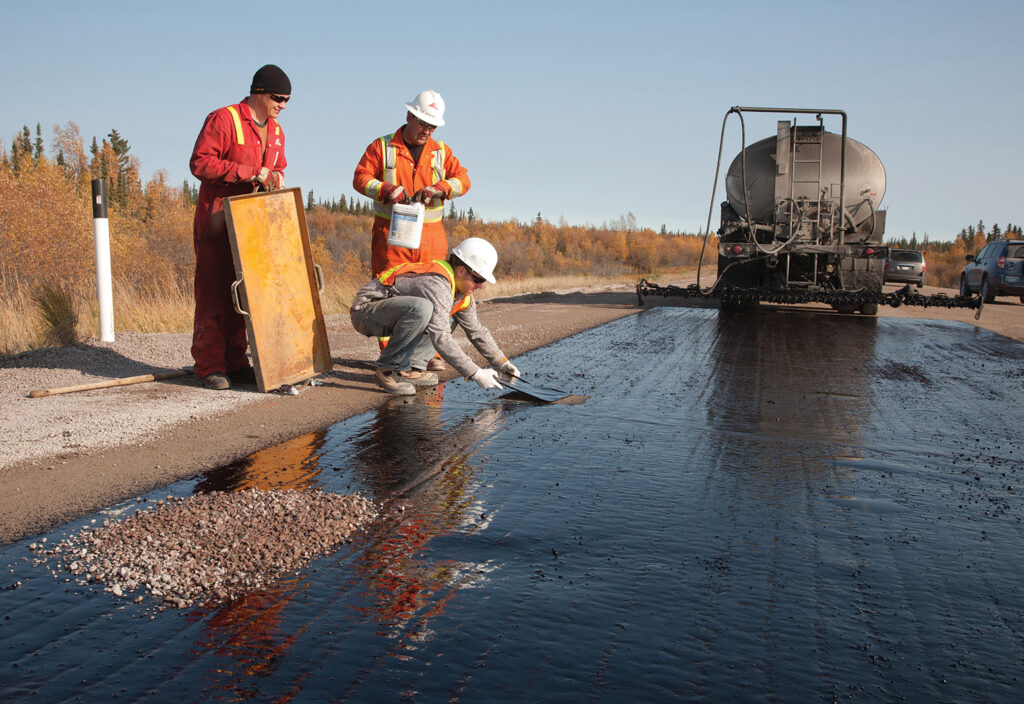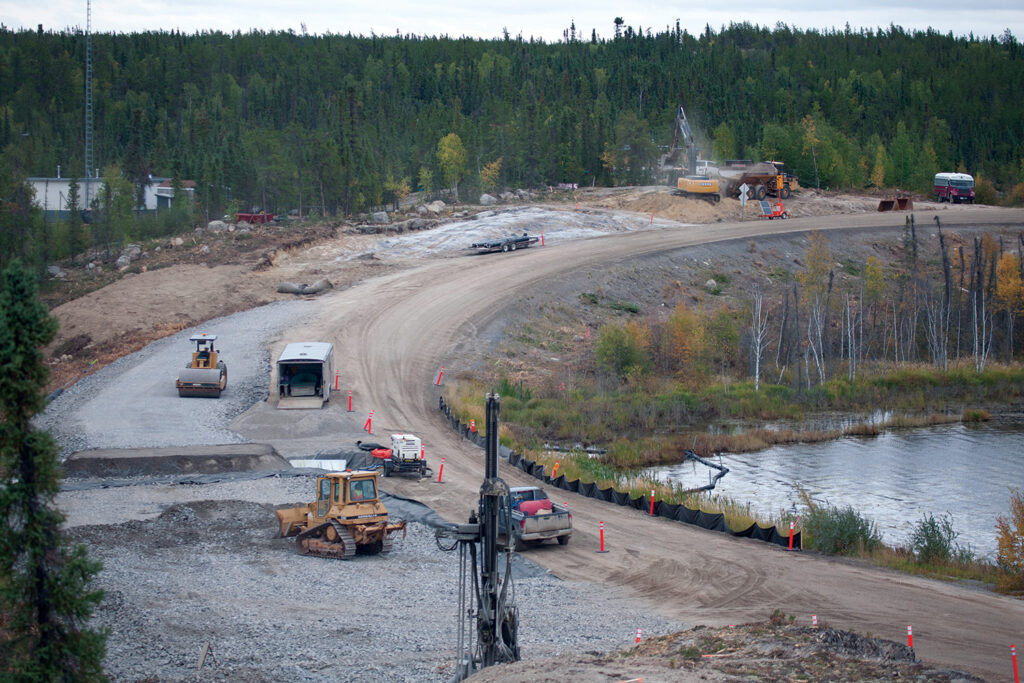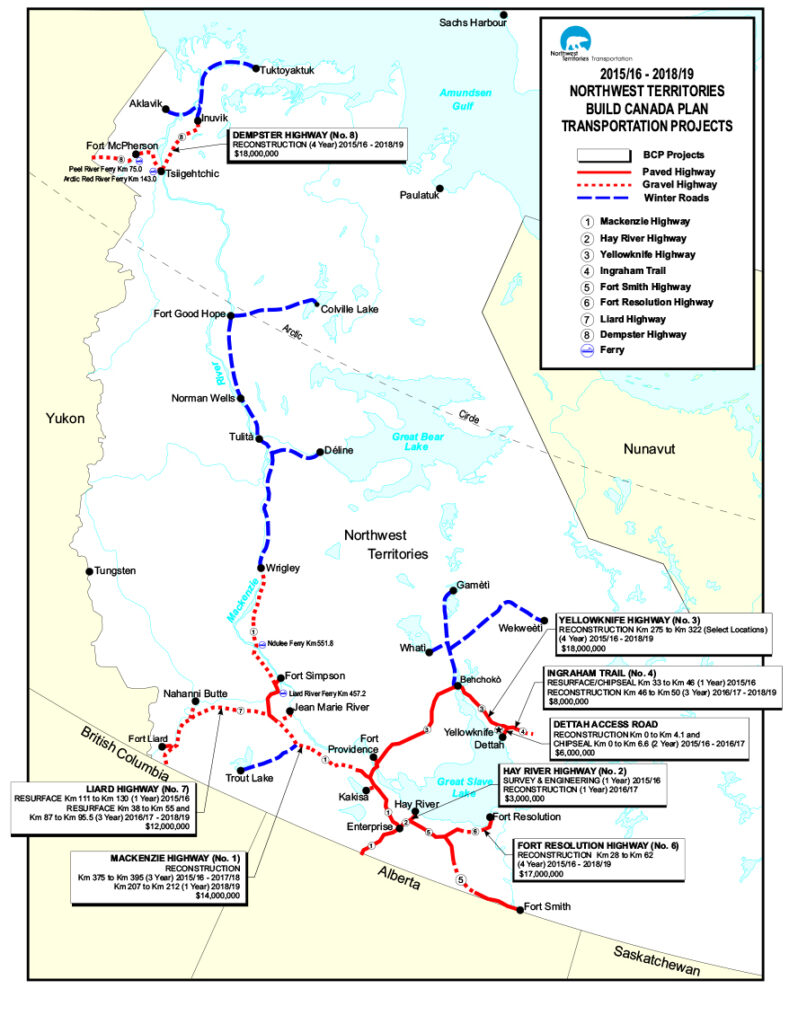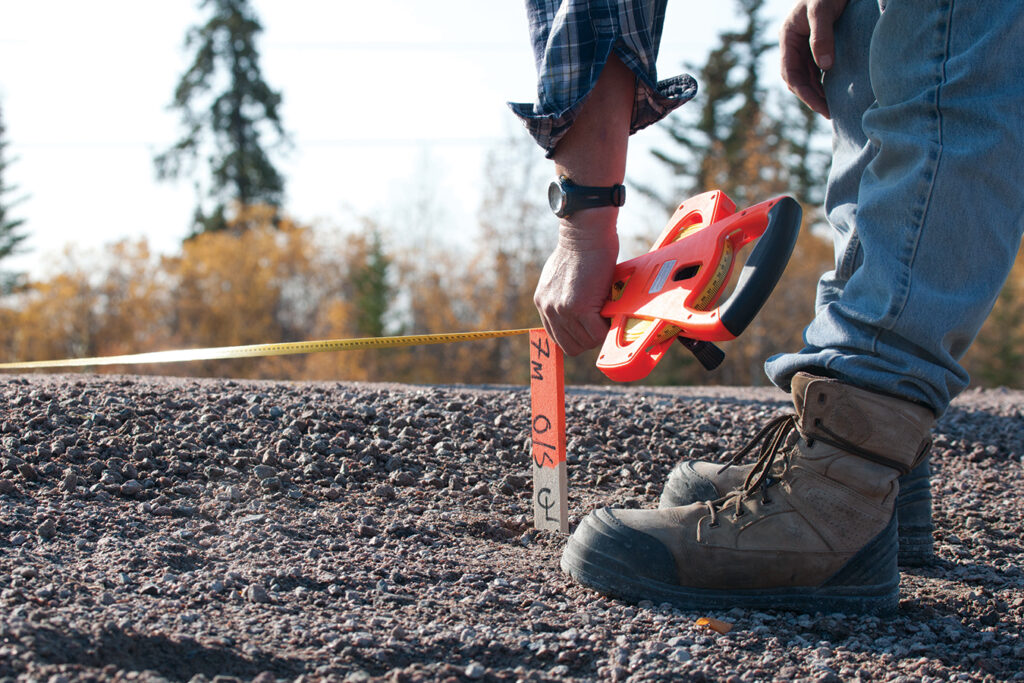Paving the roads with good intentions – and chipseal
The NWT has a lot of geography and only a few roads. Fixing them can leave large potholes in the GNWT annual budget

By Beverly Cramp
The physical area of the Northwest Territories covers a lot of ground – 1,183,085 sq km (456,792 sq mi) of it. The NWT highway system covers substantially less – 3,835 km of all-weather highway and winter roads, stretching from the NWT – Alberta border, and will soon reach all the way to Tuktoyaktuk, upon that road’s completion in 2017. The highway system is connected across major rivers by four ferry and ice crossings, and more than 300 bridges and major structures. Much of the highway system is in the southern section of the territory where about three-quarters of the Territory’s small population of 41,462 dwells.
Some years, all of these numbers can add up to GNWT road repair budget shortfalls. Earlier in 2015, an application was made to the federal government, under the NWT Highway Capacity Upgrade Project, for funding from the federal government’s New Building Canada Plan, to upgrade and repair several stretches of all-weather highway. In July 2015, the newly renamed Northwest Territories Highway Improvement Project received a combined total of $96 million – up to $72 million from the federal government and $24 million from the GNWT – all to be allocated to highway projects over the next four years for rehabilitation, repair and improving structural capacity. Federal dollars are crucial to these projects, said NWT Premier Bob McLeod, at the time of the announcement. “Investments in transportation infrastructure, including improvements to existing highways, contribute to the economic prosperity of the NWT, lower the cost of living and improve the lives of our residents.”

The Project allocates funding to nearly every NWT highway over the four-year funding lifespan. Heavily used routes such as the Mackenzie Highway (Hwy #1) has $14 million allocated for sections of embankment and drainage improvements and chip seal surfacing between Km 207 and Km 690; the Hay River Highway (Hwy #2) gets $3 million for highway realignment at Km 8 and Km 11 to limit flooding from the Hay River; and the Yellowknife Highway (Hwy #3) will have $18 million allocated between Km 239 to 339, for road strengthening, chip seal surfacing, and drainage improvements. Other planned highway projects include: $8 million for the Ingraham Trail (Hwy #4) for reconstruction, resurfacing, drainage improvements and chip seal, surfacing; $17 million for the Fort Resolution Highway (Hwy #6) for sections of reconstruction, highway widening and strengthening, and chip seal surfacing; $12 million for the Liard Highway (Hwy #7) for highway widening, strengthening, drainage improvement, guardrail placement, and chip seal surfacing, to cost; $18 million for improvements to surface conditions between km 0 and 272 on the Dempster Highway (Hwy #8) in the Mackenzie Delta; and $6 million for the Dettah access road for reconstruction and chip seal surfacing.

The announcement warmed the hearts of construction company presidents and project managers throughout the NWT. Jack Rowe, president of Hay River – based Rowe’s Construction, which was contracted for some of the work listed above, says the number of projects, the funding allocated to them and the four-year project time frame allows the company to do some medium-term planning. “This represents work we can coordinate over the next four years,” Rowe says. His company worked on the Liard and Mackenzie highways this past summer and fall. “We plan to continue that work and add additional construction projects on the Yellowknife and Fort Resolution highways and maybe some on the Ingraham Trail.” RTL-Robinson Enterprises from Yellowknife was also pleased with the announced highway improvement projects. RTL won a $3.5 million contract for a 4 km stretch of reconstruction and repair on Highway 3, between Yellowknife and Bechoko, which was just completed. RTL project manager Barry Henckel says the reconstruction work involved leveling out the uneven road surface caused by the new highway’s settling since the entire stretch from Yellowknife to Bechoko was rebuilt a few years ago. “This is still a new road,” says Henckel. There are several transitions from muskeg to hard rock along this highway and that is where the road can slump, creating road safety hazards, he says. These sections needed strengthening with crushed rock and widening in the ditches to stabilize the areas. “This road is finally starting to settle down and even out,” says Henckel. “It’s hard to say how many more years this will take.”

Henckel says RTL will submit bids again for work in the next years of these projects. “It’s the normal operating procedure for us,” he says of the tendering process. “And it’s the best way for the government to get the best price.” Rowe’s worked on the Mackenzie Highway in partnership with Nogha Enterprises, the economic development arm of the Liidlii Kue First Nation in Fort Simpson, and Jean Marie River First Nation. Work on the Fort Resolution Highway is in partnership with the Deninu Kue First Nation and the Fort Resolution Métis Council. Construction projects on the Liard Highway are being done in partnership with Beaver Enterprises, Acho Dene Koe’s construction company. The new projects provide Rowe’s with the work needed to maintain its workforce of about 200, who will likely be working on Highways 7, 1 and 6. They are also important for the longer-term planning they allow construction companies to do. “We typically only know what we will be doing year-to-year,” says Ronald Schaub, Rowe’s general manager. “Usually we don’t know until March, when the job tenders come out, what we will be doing for the rest of the year. Now we can plan two and three years ahead.” Schaub says this means they can hire people for longer periods, two to three years, than just seasonal terms. For some jobs, employees can be hired for projects near their hometowns, which is even better for them, says Schaub. “ We don’t have to get them out of their communities to live in other places to work. Morale is so much better if people can work close to home.”

Highway improvement projects are good for the NWT economy for several reasons. Good roads facilitate the smooth movement of freight for industry and consumers and contribute to lowering the cost of living and doing business. Good roads facilitate tourism and can make the NWT look prosperous and well-managed. Roads that look bad are bad for business, says Schaub, because bad roads scare away the resource sector, whether in mining or forestry. “When bridges and roads are in such disrepair, it hinders companies investing as it makes projects cost prohibitive due to the decreased weights the infrastructure can support. This drives up transportation costs,” Schaub says. “I hear it over and over. So that’s another reason for beefing up our transportation infrastructure.” CN

